Inhibitory Effects of Thymol Isolated from Curcuma longa L. on Adipogenesis in HepG2 Cells
Abstract
1. Introduction
2. Results
2.1. Identification and Quantification of Thymol in Curcuma Longa
2.2. HepG2 Cells’ Viability Based on Thymol (THY)
2.3. Effects on Intracellular Lipid Accumulation in HepG2 Cells
2.4. Effects on TG and TC Levels in HepG2 Cells
2.5. Effects on Hepatic Lipid Accumulation and Protein Expression
2.6. Effects on Hepatic Lipid Accumulation and mRNA Expression
2.7. Effects on AMPK Expression in HepG2 Cells
3. Discussion
4. Materials and Methods
4.1. Extraction and Isolation Procedure
4.2. High-Performance Liquid Chromatography Analysis
4.3. Materials and Reagents
4.4. Cell Culture
4.5. Cell Viability
4.6. Oil Red O Staining
4.7. Measurement of Lipid Levels
4.8. Western Blot Analysis
4.9. Real-Time RT-PCR
4.10. Statistical Analysis
Supplementary Materials
Author Contributions
Funding
Conflicts of Interest
References
- Sanyal, A.J.; Brunt, E.M.; Kleiner, D.E.; Kowdley, K.V.; Chalasani, N.; Lavine, J.E.; Ratziu, V.; McCullough, A. Endpoints and clinical trial design for nonalcoholic steatohepatitis. Hepatology 2011, 54, 344–353. [Google Scholar] [CrossRef] [PubMed]
- Kang, O.H.; Kim, S.B.; Seo, Y.S.; Joung, D.K.; Mun, S.H.; Choi, J.G.; Lee, Y.M.; Kang, D.G.; Lee, H.S.; Kwon, D.Y. Curcumin decreases oleic acid-induced lipid accumulation via AMPK phosphorylation in hepatocarcinoma cells. Eur. Rev. Med. Pharmacol. Sci. 2013, 17, 2578–2586. [Google Scholar] [PubMed]
- Rinella, M.E. Nonalcoholic fatty liver disease: A systematic review. JAMA 2015, 313, 2263–2273. [Google Scholar] [CrossRef] [PubMed]
- Kleiner, D.E.; Makhlouf, H.R. Histology of Nonalcoholic Fatty Liver Disease and Nonalcoholic Steatohepatitis in Adults and Children. Clin. Liver Dis. 2016, 20, 293–312. [Google Scholar] [CrossRef] [PubMed]
- Kim, M.C.; Kong, Y.; Han, H.S.; Kang, D.H.; Lee, S.J.; Lee, C.H.; Wang, S.; Kwon, D.Y.; Kang, O.H. Non-alcoholic fatty liver protective effects, and studies on the mechanism of action of Crataegi Fructus. Korea J. Herbol. 2018, 33, 61–70. [Google Scholar]
- Karlowicz-Bodalska, K.; Han, S.; Freier, J.; Smolenski, M.; Bodalska, A. Curcuma Longa as Medicinal Herb in the Treatment of Diabet- IC Complications. Acta Pol. Pharm. 2017, 74, 605–610. [Google Scholar] [PubMed]
- Chen, I.N.; Chang, C.C.; Ng, C.C.; Wang, C.Y.; Shyu, Y.T.; Chang, T.L. Antioxidant and antimicrobial activity of Zingiberaceae plants in Taiwan. Plant Foods Hum. Nutr. 2008, 63, 15–20. [Google Scholar] [CrossRef] [PubMed]
- Chen, C.; Long, L.; Zhang, F.; Chen, Q.; Chen, C.; Yu, X.; Liu, Q.; Bao, J.; Long, Z. Antifungal activity, main active components and mechanism of Curcuma longa extract against Fusarium graminearum. PLoS ONE 2018, 13, e0194284. [Google Scholar] [CrossRef] [PubMed]
- Pandey, K.P.; Mishra, R.K.; Kamran, A.; Mishra, P.; Bajaj, A.K.; Dikshit, A. Studies on antidermatophytic activity of waste leaves of Curcuma longa L. Physiol. Mol. Biol. Plants 2010, 16, 177–185. [Google Scholar] [CrossRef] [PubMed][Green Version]
- Lestari, M.L.; Indrayanto, G. Curcumin. Profiles Drug Subst. Excip. Relat. Methodol. 2014, 39, 113–204. [Google Scholar] [PubMed]
- Yu, Y.M.; Chao, T.Y.; Chang, W.C.; Chang, M.J.; Lee, M.F. Thymol reduces oxidative stress, aortic intimal thickening, and inflammation-related gene expression in hyperlipidemic rabbits. J. Food Drug Anal. 2016, 24, 556–563. [Google Scholar] [CrossRef] [PubMed]
- Oskouei, B.G.; Abbaspour-Ravasjani, S.; Jamal Musavinejad, S.; Ahmad Salehzadeh, S.; Abdolhosseinzadeh, A.; Hamishehkar, H.; Ghahremanzadeh, K.; Shokouhi, B. In vivo Evaluation of Anti-Hyperglycemic, Anti-hyperlipidemic and Anti-Oxidant Status of Liver and Kidney of Thymol in STZ-Induced Diabetic Rats. Drug Res. 2019, 69, 46–52. [Google Scholar] [CrossRef] [PubMed]
- Khan, S.T.; Khan, M.; Ahmad, J.; Wahab, B.; Abd-Elkader, O.; Musarrat, H.; Alkhathlan, H.; Al-kedhairy, A. Thymol and carvacrol induce autolysis, stress, growth inhibition and reduce the biofilm formation by Streptococcus mutans. AMB Express 2017, 7, 1–11. [Google Scholar] [CrossRef] [PubMed]
- Brown, M.S.; Goldstein, J.L. The SREBP pathway: Regulation of cholesterol metabolism by proteolysis of a membrane-bound transcription factor. Cell 1997, 89, 331–340. [Google Scholar] [CrossRef]
- Horton, J.D.; Goldstein, J.L.; Brown, M.S. SREBPs: Activators of the complete program of cholesterol and fatty acid synthesis in the liver. J. Clin. Investig. 2002, 109, 1125–1131. [Google Scholar] [CrossRef] [PubMed]
- Mingrone, G.; Rosa, G.; Greco, A.V.; Manco, M.; Vega, N.; Nanni, G.; Castagneto, M.; Vidal, H. Intramyocitic lipid accumulation and SREBP-1c expression are related to insulin resistance and cardiovascular risk in morbid obesity. Atherosclerosis 2003, 170, 155–161. [Google Scholar] [CrossRef]
- Jensen-Urstad, A.P.; Sememenkovich, C.F. Fatty acid synthase and liver triglyceride metabolism: Housekeeper or messenger? Biochim. Biophys. Acta 2012, 1821, 747–753. [Google Scholar] [CrossRef] [PubMed]
- Lee, C.H.; Olson, P.; Evans, R.M. Minireview: Lipid metabolism, metabolic diseases, and peroxisome proliferator-activated receptors. Endocrinology 2003, 144, 2201–2207. [Google Scholar] [CrossRef] [PubMed]
- Yang, J.; Goldstein, J.L.; Hammer, R.E.; Moon, Y.A.; Brown, M.S.; Horton, J.D. Decreased lipid synthesis in livers of mice with disrupted Site-1 protease gene. Proc. Natl. Acad. Sci. USA 2001, 98, 13607–13612. [Google Scholar] [CrossRef] [PubMed]
- Lee, Y.K.; Lee, W.S.; Hwang, J.T.; Kwon, D.Y.; Surh, Y.J.; Park, O.J. Curcumin exerts antidifferentiation effect through AMPKalpha-PPAR-gamma in 3T3-L1 adipocytes and antiproliferatory effect through AMPKalpha-COX-2 in cancer cells. J. Agric. Food Chem. 2009, 57, 305–310. [Google Scholar] [CrossRef] [PubMed]
Sample Availability: Not available. |
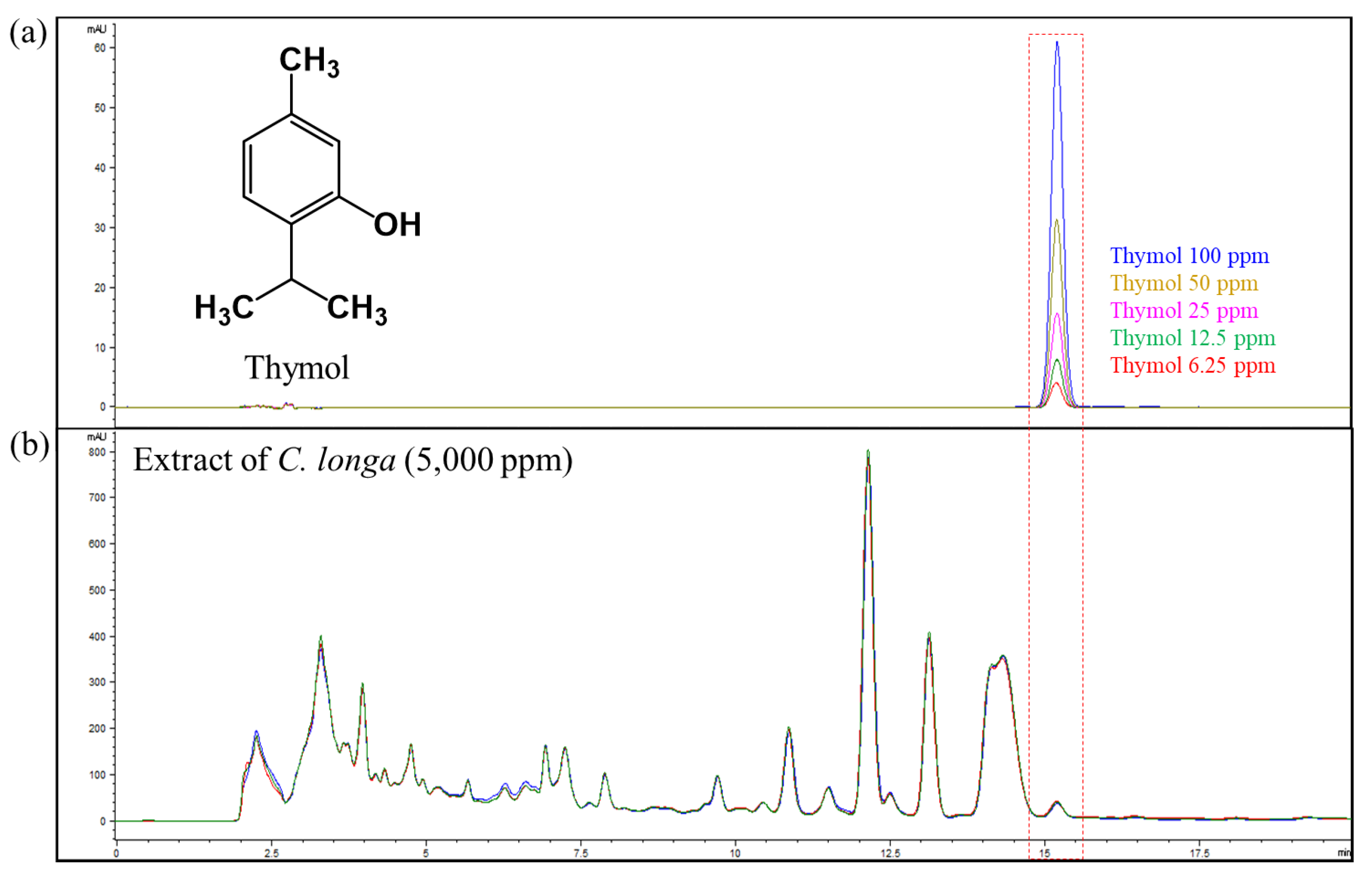
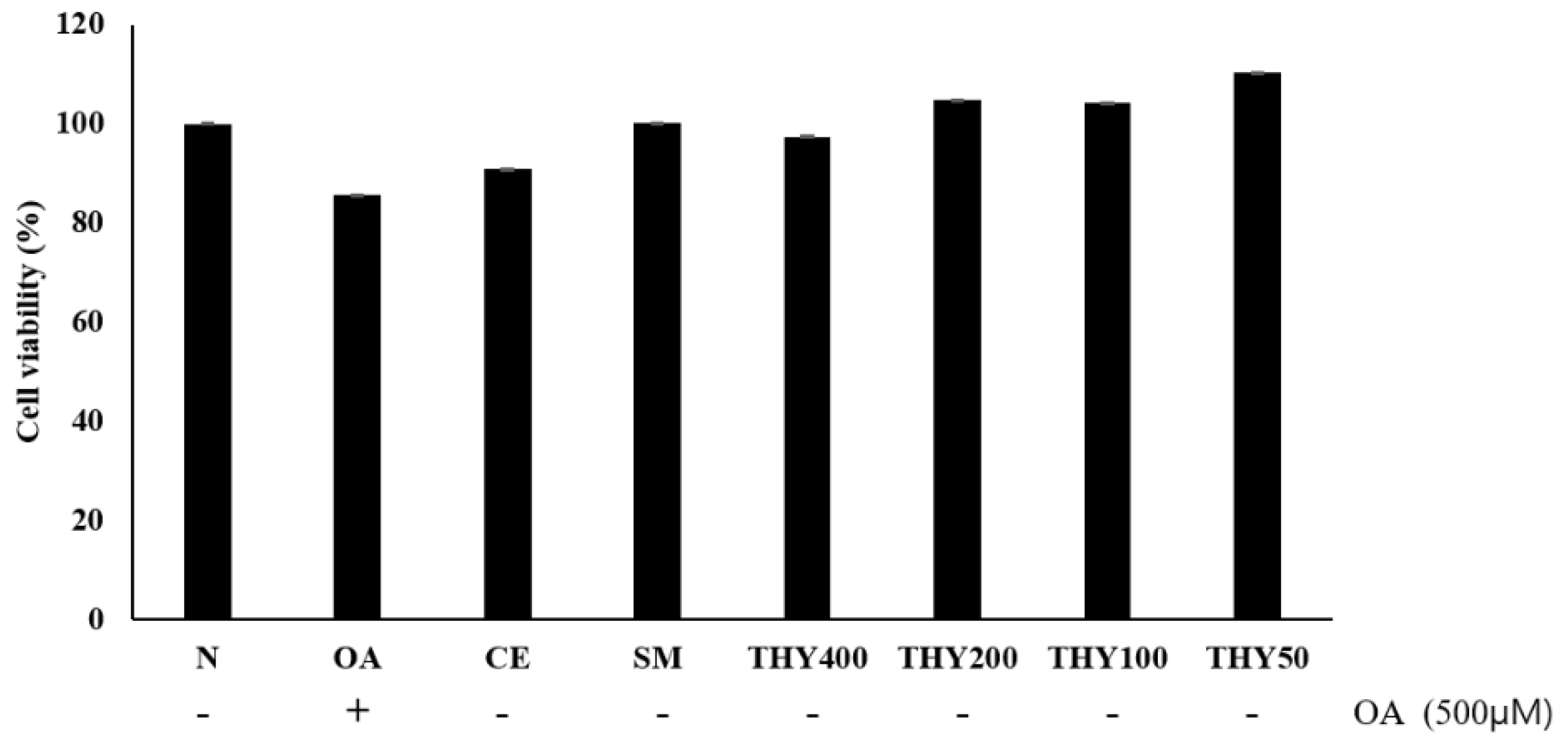
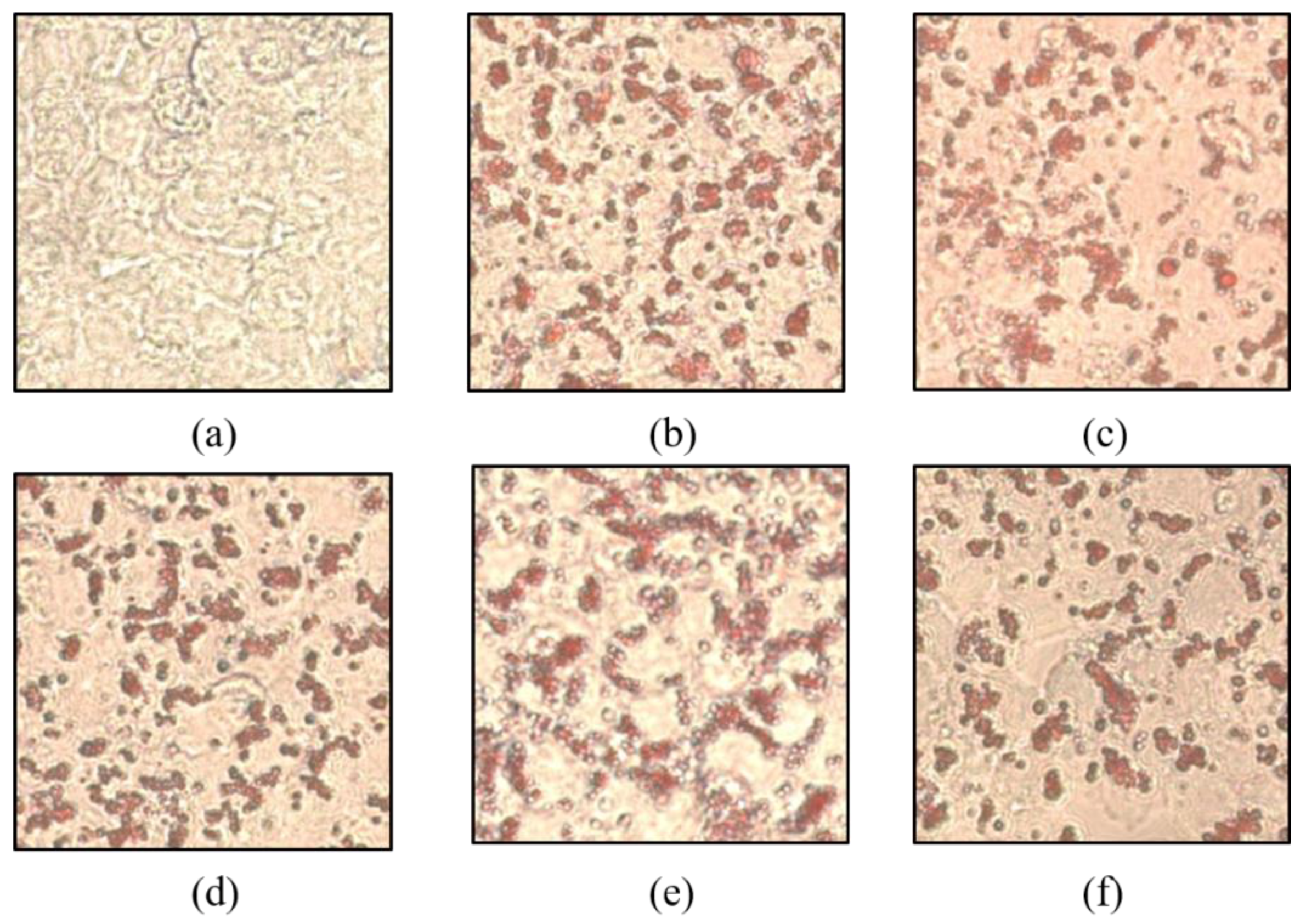

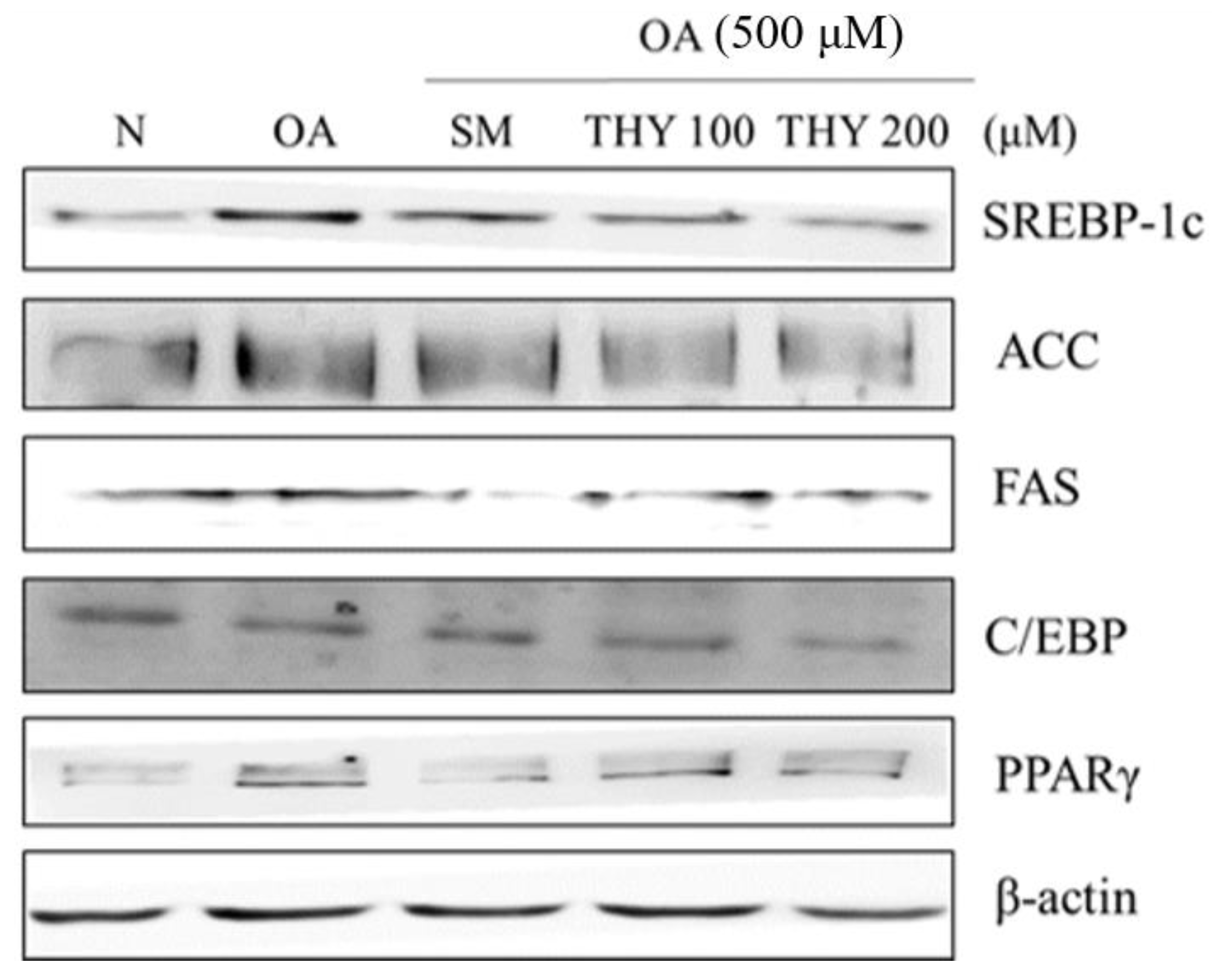
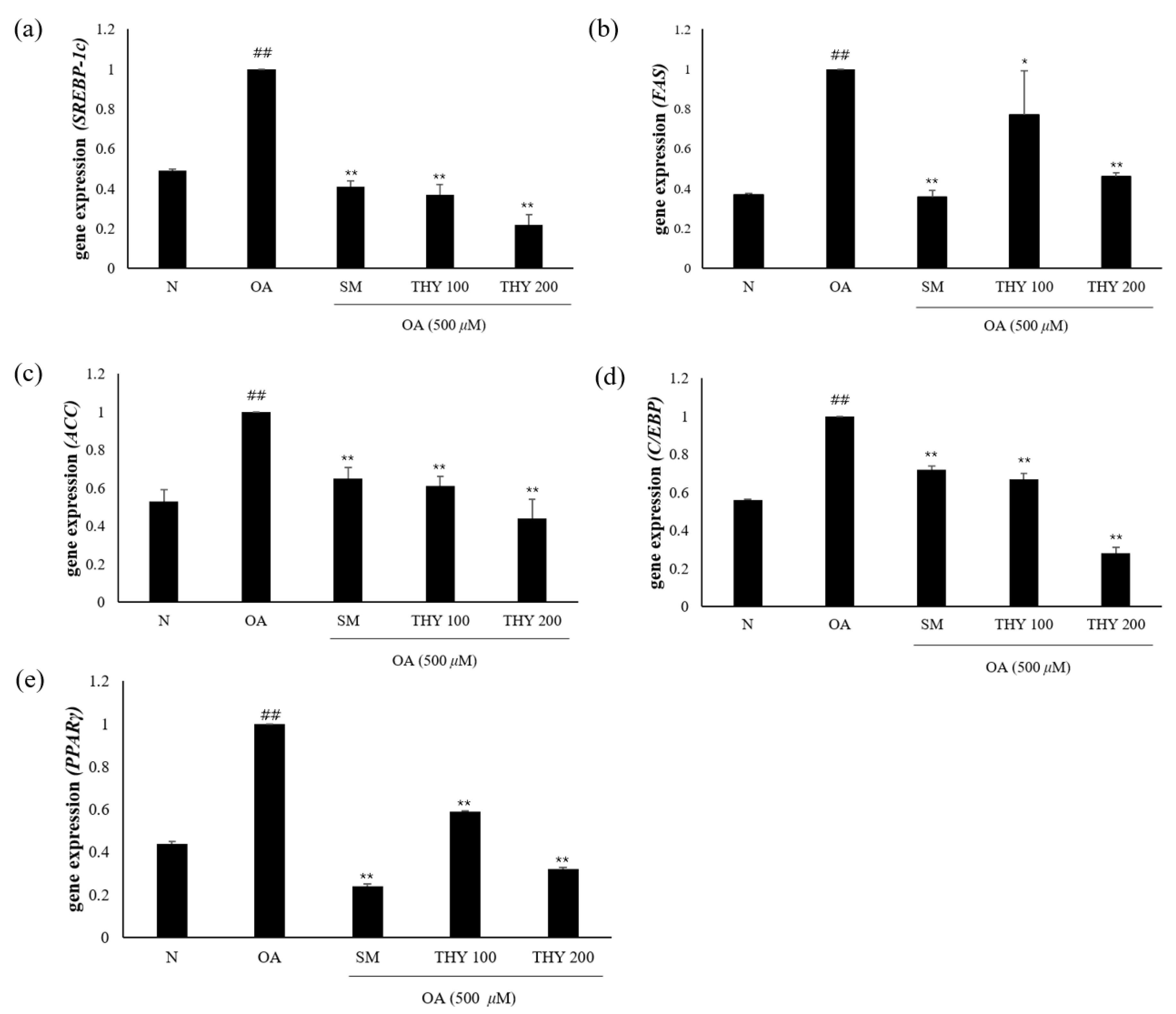
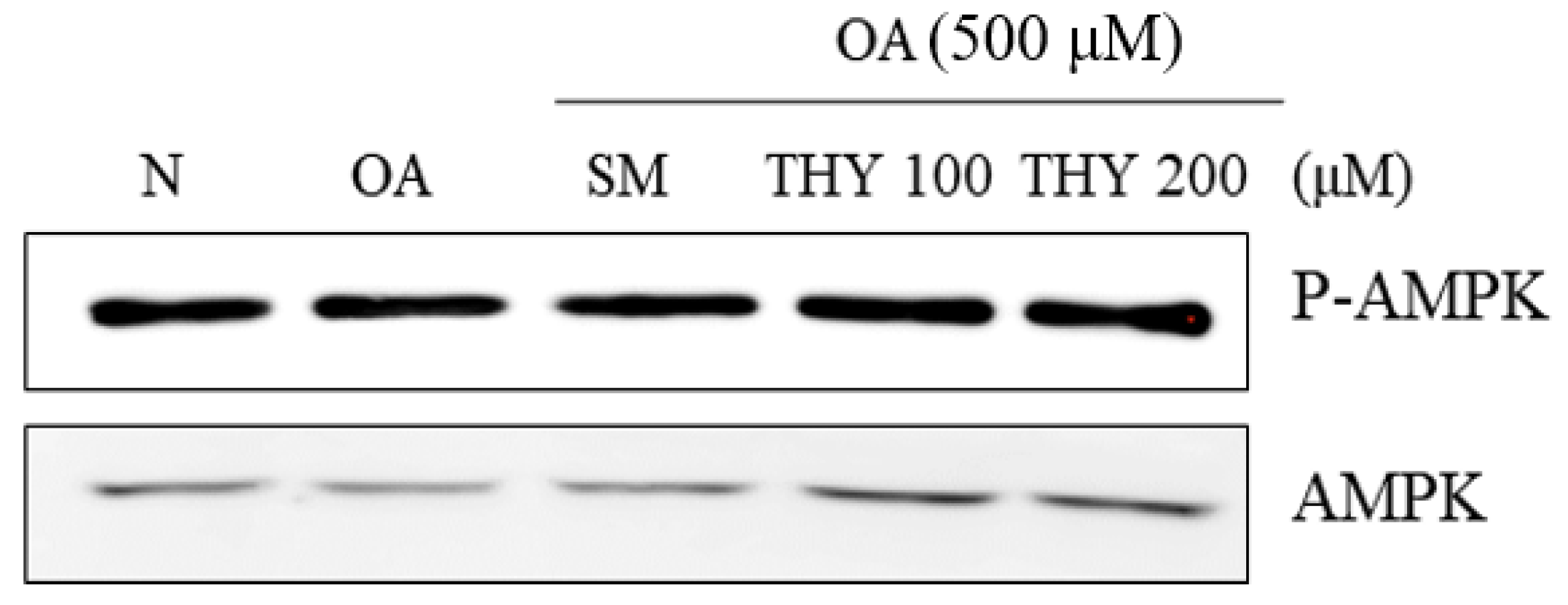
| Target Genes | Primer Sequences | |
|---|---|---|
| Forward Primer | Reverse Primer | |
| SREBP-1c | CGC AAG GCC ATC GAC TAC AT | GAC TTA GGT TCT CCT GCT TGA GTT TC |
| FAS | AAG GAC CTG TCT AGG TTT GAT GC | TGG CTT CAT AGG TGA CTT CCA |
| ACC | TCG CTT TGG GGG AAA TAA AGT G | ACC ACC TAC GGA TAG ACC GC |
| C/EBP | CAA GCA CAG CGA CGA GTA CAA | GCT TGA ACA AGT TCC GCA GGG |
| PPARγ | GCA GGC TCC ACT TTG ATT | ACC ACT CCC ACT CCT TTG |
| GAPDH | CAG GGC TGC TTT TAA CTC TGG T | GAT TTT GGA GGG ATC TCG CT |
© 2020 by the authors. Licensee MDPI, Basel, Switzerland. This article is an open access article distributed under the terms and conditions of the Creative Commons Attribution (CC BY) license (http://creativecommons.org/licenses/by/4.0/).
Share and Cite
Kang, D.-H.; Lee, Y.-S.; Oh, S.M.; Yoon, D.; Choi, D.J.; Kwon, D.-Y.; Kang, O.-H.; Lee, D.Y. Inhibitory Effects of Thymol Isolated from Curcuma longa L. on Adipogenesis in HepG2 Cells. Processes 2020, 8, 1191. https://doi.org/10.3390/pr8091191
Kang D-H, Lee Y-S, Oh SM, Yoon D, Choi DJ, Kwon D-Y, Kang O-H, Lee DY. Inhibitory Effects of Thymol Isolated from Curcuma longa L. on Adipogenesis in HepG2 Cells. Processes. 2020; 8(9):1191. https://doi.org/10.3390/pr8091191
Chicago/Turabian StyleKang, Dam-Hee, Young-Seob Lee, Seon Min Oh, Dahye Yoon, Doo Jin Choi, Dong-Yeul Kwon, Ok-Hwa Kang, and Dae Young Lee. 2020. "Inhibitory Effects of Thymol Isolated from Curcuma longa L. on Adipogenesis in HepG2 Cells" Processes 8, no. 9: 1191. https://doi.org/10.3390/pr8091191
APA StyleKang, D.-H., Lee, Y.-S., Oh, S. M., Yoon, D., Choi, D. J., Kwon, D.-Y., Kang, O.-H., & Lee, D. Y. (2020). Inhibitory Effects of Thymol Isolated from Curcuma longa L. on Adipogenesis in HepG2 Cells. Processes, 8(9), 1191. https://doi.org/10.3390/pr8091191






